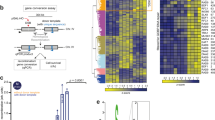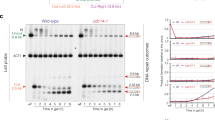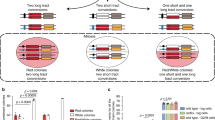Abstract
The genome is constantly subjected to chemical alterations that have the potential to cause genetic mutation, chromosomal rearrangements and, in the case of multicellular organisms, cancer. Particular vulnerability exists during DNA replication, when the two DNA strands of a chromosome separate to form templates for the synthesis of sister chromatids. Attempted replication across a damaged or nicked DNA template can result in the formation of a double-strand break (DSB), arguably the most dangerous of DNA lesions. DSBs can also arise directly at any cell cycle stage following exposure to ionizing radiation or radiomimetic agents. To combat these recurrent threats of genomic instability, numerous distinct enzyme systems have evolved that sense DNA damage and coordinate its repair. Part of this coordination involves the activation of signal transduction cascades that target repair proteins, trigger DNA damage-dependent cell cycle checkpoints and profoundly affect chromatin neighboring a DSB. Here, we discuss current models of how lesion processing itself helps to coordinate these signals in dividing cells. Recent evidence in yeast of a role for cyclin-dependent kinases in DNA end resection suggests a possible solution to the long-standing puzzle of how DSBR pathway ‘choice’ is regulated through the cell cycle.
This is a preview of subscription content, access via your institution
Access options
Subscribe to this journal
Receive 50 print issues and online access
$259.00 per year
only $5.18 per issue
Buy this article
- Purchase on Springer Link
- Instant access to full article PDF
Prices may be subject to local taxes which are calculated during checkout


Similar content being viewed by others
References
Abraham RT . (2004). DNA Repair (Amst.), 3, 883–887.
Anderson DG and Kowalczykowski SC . (1997). Genes Dev., 11, 571–581.
Bassing CH, Swat W and Alt FW . (2002). Cell, 109 (Suppl), S45–S55.
Bermudez VP, Lindsey-Boltz LA, Cesare AJ, Maniwa Y, Griffith JD, Hurwitz J and Sancar A . (2003). Proc. Natl. Acad. Sci. USA, 100, 1633–1638.
Bessho T and Sancar A . (2000). J. Biol. Chem., 275, 7451–7454.
Chen Y and Sanchez Y . (2004). DNA Repair (Amst.), 3, 1025–1032.
Cox MM, Goodman MF, Kreuzer KN, Sherratt DJ, Sandler SJ and Marians KJ . (2000). Nature, 404, 37–41.
Critchlow SE and Jackson SP . (1998). Trends Biochem. Sci., 23, 394–398.
de Jager M, van Noort J, van Gent DC, Dekker C, Kanaar R and Wyman C . (2001). Mol. Cell, 8, 1129–1135.
Griffith JD, Lindsey-Boltz LA and Sancar A . (2002). J. Biol. Chem., 277, 15233–15236.
Haber JE . (1999). Nature, 398, 665–667.
Hekmat-Nejad M, You Z, Yee MC, Newport JW and Cimprich KA . (2000). Curr. Biol., 10, 1565–1573.
Ira G, Pellicioli A, Balijja A, Wang X, Fiorani S, Carotenuto W, Liberi G, Bressan D, Wan L, Hollingsworth NM, Haber JE and Foiani M . (2004). Nature, 431, 1011–1017.
Kowalczykowski SC . (2000). Trends Biochem. Sci., 25, 156–165.
Krogh BO and Symington LS . (2004). Annu. Rev. Genet., 38, 233–271.
Kumagai A, Kim SM and Dunphy WG . (2004). J. Biol. Chem., 279, 49599–49608.
Lee GS, Neiditch MB, Salus SS and Roth DB . (2004). Cell, 117, 171–184.
Lee J, Kumagai A and Dunphy WG . (2003). Mol. Cell, 11, 329–340.
Lin SY, Li K, Stewart GS and Elledge SJ . (2004). Proc. Natl. Acad. Sci. USA, 101, 6484–6489.
Lisby M, Barlow JH, Burgess RC and Rothstein R . (2004). Cell, 118, 699–713.
Liskay RM, Letsou A and Stachelek JL . (1987). Genetics, 115, 161–167.
Llorente B and Symington LS . (2004). Mol. Cell. Biol., 24, 9682–9694.
Lomonosov M, Anand S, Sangrithi M, Davies R and Venkitaraman AR . (2003). Genes Dev., 17, 3017–3022.
Mirzoeva OK and Petrini JH . (2003). Mol. Cancer Res., 1, 207–218.
Osborn AJ, Elledge SJ and Zou L . (2002). Trends Cell Biol., 12, 509–516.
Parrilla-Castellar ER, Arlander SJ and Karnitz L . (2004). DNA Repair (Amst.), 3, 1009–1014.
Parrilla-Castellar ER and Karnitz LM . (2003). J. Biol. Chem., 278, 45507–45511.
Paulovich AG, Toczyski DP and Hartwell LH . (1997). Cell, 88, 315–321.
Ristic D, Modesti M, Kanaar R and Wyman C . (2003). Nucleic Acids Res., 31, 5229–5237.
Roos-Mattjus P, Hopkins KM, Oestreich AJ, Vroman BT, Johnson KL, Naylor S, Lieberman HB and Karnitz LM . (2003). J. Biol. Chem., 278, 24428–24437.
Rubnitz J and Subramani S . (1984). Mol. Cell. Biol., 4, 2253–2258.
Scully R and Livingston DM . (2000). Nature, 408, 429–432.
Seigneur M, Bidnenko V, Ehrlich SD and Michel B . (1998). Cell, 95, 419–430.
Shechter D, Costanzo V and Gautier J . (2004). DNA Repair (Amst.), 3, 901–908.
Shroff R, Arbel-Eden A, Pilch D, Ira G, Bonner WM, Petrini JH, Haber JE and Lichten M . (2004). Curr. Biol., 14, 1703–1711.
Sogo JM, Lopes M and Foiani M . (2002). Science, 297, 599–602.
Stracker TH, Theunissen JW, Morales M and Petrini JH . (2004). DNA Repair (Amst.), 3, 845–854.
Van Dyck E, Stasiak AZ, Stasiak A and West SC . (2001). EMBO Rep., 2, 905–909.
Wyman C, Ristic D and Kanaar R . (2004). DNA Repair (Amst.), 3, 827–833.
Zou L, Cortez D and Elledge SJ . (2002). Genes Dev., 16, 198–208.
Zou L and Elledge SJ . (2003). Science, 300, 1542–1548.
Zou L, Liu D and Elledge SJ . (2003). Proc. Natl. Acad. Sci. USA, 100, 13827–13832.
Acknowledgements
We thank members of the Scully lab for helpful discussions. This work was supported by awards R01 CA95175, ACS grant RSG-04-198-01-MGO and a Pew Scholars Award (to RS).
Author information
Authors and Affiliations
Corresponding author
Rights and permissions
About this article
Cite this article
Scully, R., Xie, A. In my end is my beginning: control of end resection and DSBR pathway ‘choice’ by cyclin-dependent kinases. Oncogene 24, 2871–2876 (2005). https://doi.org/10.1038/sj.onc.1208609
Published:
Issue Date:
DOI: https://doi.org/10.1038/sj.onc.1208609
Keywords
This article is cited by
-
PAXX Participates in Base Excision Repair via Interacting with Pol β and Contributes to TMZ Resistance in Glioma Cells
Journal of Molecular Neuroscience (2018)
-
Forced activation of Cdk1 via wee1 inhibition impairs homologous recombination
Oncogene (2013)



